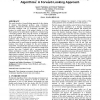Free Online Productivity Tools
i2Speak
i2Symbol
i2OCR
iTex2Img
iWeb2Print
iWeb2Shot
i2Type
iPdf2Split
iPdf2Merge
i2Bopomofo
i2Arabic
i2Style
i2Image
i2PDF
iLatex2Rtf
Sci2ools
GECCO
2006
Springer
2006
Springer
Dynamic multi-objective optimization with evolutionary algorithms: a forward-looking approach
This work describes a forward-looking approach for the solution of dynamic (time-changing) problems using evolutionary algorithms. The main idea of the proposed method is to combine a forecasting technique with an evolutionary algorithm. The location, in variable space, of the optimal solution (or of the Pareto optimal set in multi-objective problems) is estimated using a forecasting method. Then, using this forecast, an anticipatory group of individuals is placed on and near the estimated location of the next optimum. This prediction set is used to seed the population when a change in the objective landscape arrives, aiming at a faster convergence to the new global optimum. The forecasting model is created using the sequence of prior optimum locations, from which an estimate for the next location is extrapolated. Conceptually this approach encompasses advantages of memory methods by making use of information available from previous time steps. Combined with a convergence/diversity ba...
Evolutionary Algorithm | GECCO 2006 | Multi-objective Problems | Optimization | Pareto Optimal Set |
| Added | 23 Aug 2010 |
| Updated | 23 Aug 2010 |
| Type | Conference |
| Year | 2006 |
| Where | GECCO |
| Authors | Iason Hatzakis, David Wallace |
Comments (0)

